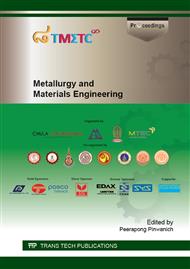p.3
p.8
p.14
p.19
p.25
p.31
p.36
p.42
Effect of Alloying Modification in Arc Melted Hastelloy X on Microstructures and Oxidation Resistance at Elevated Temperatures
Abstract:
The present research work has an aim to modify microstructure and oxidation behavior of Hastelloy X, a solid solution nickel base alloy, by both aluminium and titanium additions by mean of arc melting process. The Hastelloy X was added both Al and Ti (50:50) for 2% 4% and 6% by weight and casted by vacuum arc melting furnace. Then all received specimens were performed heat treatment, which consist of solutioning treatment at 1175°C for 4 hours and aging temperatures for 760°C, 800°C and 845°C for 24 hours. From the obtained results, it was found that the amount of both Al and Ti additions as well as precipitation aging temperature provided significant effect on both final microstructure and oxidation behaviors at 900°C and 1000°C. Widmanstatten type of microstructure was found in many case. Intermetallic phase formation of molybdenum and chromium was also found in all cases by element mapping. This phase should be γ’-phase. Both aluminium and titanium additions could not provide beneficial effect on oxidation resistance tests at temperature of 900°C and 1000°C. However, with 4%wt. of both aluminium and titanium addition, it resulted in slightly increasing of oxidation resistance at temperature of 1000°C
Info:
Periodical:
Pages:
8-13
Citation:
Online since:
July 2015
Authors:
Keywords:
Price:
Сopyright:
© 2015 Trans Tech Publications Ltd. All Rights Reserved
Share:
Citation:


